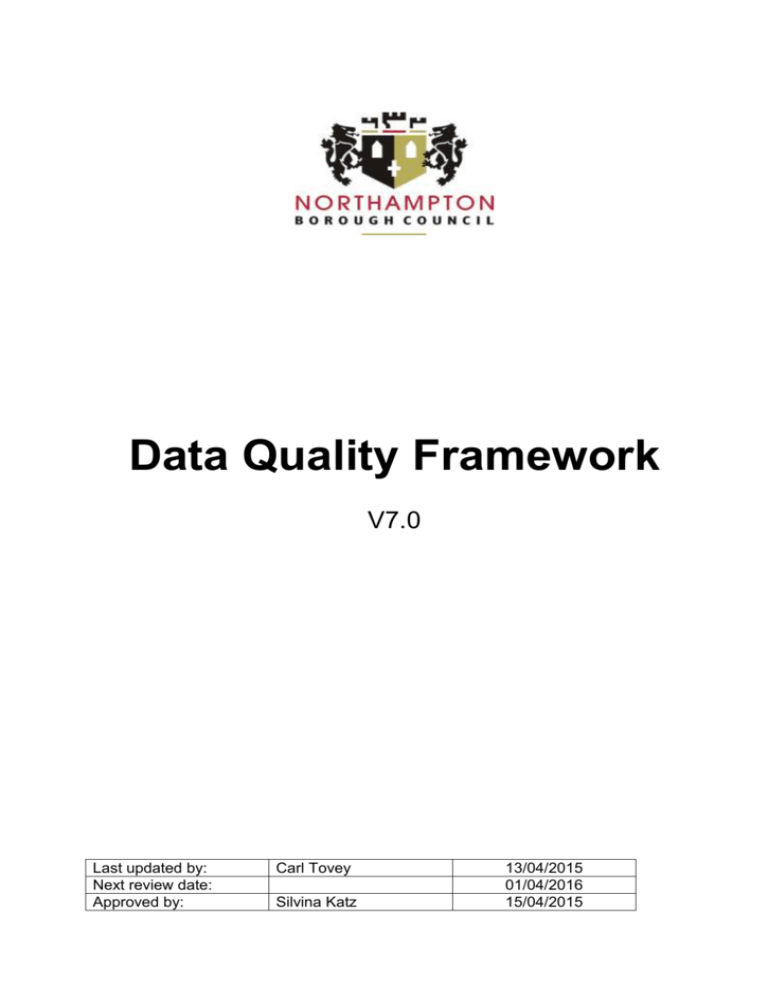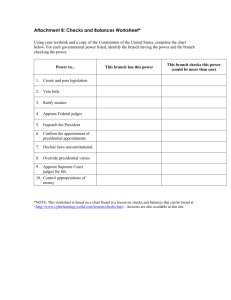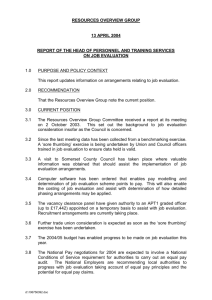Data quality roles and responsibilities
advertisement

Data Quality Framework V7.0 Last updated by: Next review date: Approved by: Carl Tovey Silvina Katz 13/04/2015 01/04/2016 15/04/2015 Data Quality Framework Introduction Northampton Borough Council is committed to continually seek to improve the quality of its data to support good decision-making and improved service outcomes. Specific data quality objectives have been agreed, and will be outlined later in the document The purpose of this framework is to define how the Council will drive data quality, and support teams to deliver the objectives, and provide guidance to improve and sustain performance. 1 Governance, leadership and delivery 1.1 Roles and Responsibilities Data quality is the responsibility of the whole Council; however there are certain roles within the Council that will more directly contribute to our approach in improving data quality. To demonstrate commitment in ensuring that data quality improvement is driven corporately and within the service areas, a lead Member and Senior Officer have been assigned specific responsibility for data quality. Our governance arrangements are: Member Lead – Cabinet member with responsibility for Performance Management (Finance Portfolio) Senior Responsible Officer – Borough Secretary, and Monitoring Officer Audit Committee Overview & Scrutiny Committee A comprehensive table detailing wider data quality roles and responsibilities within the Council is contained in Appendix C. Practical support and guidance is available as follows: Governance and data quality o Corporate Performance and Change Team Data protection and sharing, transparency, and FOI o Information Governance Team Data Quality Framework 2015 Page 2 of 11 1.2 Data quality objectives In view of the importance of data quality the Council has set the following corporate objectives: Achieve 100% accuracy first time, every time No Corporate Priority or Management Board performance indicators qualified by external auditors Ensure adherence to the Roles and Responsibilities specified in Appendix C Performance data will be collected and reported in an agreed format and to agreed timescales Each service area to ensure their own data meets the six characteristics of good quality data Annually review and update data quality procedures 2 Systems and processes 2.1 Maintenance and review of systems and processes Responsibility for maintaining a robust control environment and improving information systems rests within departments with managers, data collectors, and system users. The Corporate Performance Team will provide support for implementing and challenging improvement in this area. Each system will have a named primary and secondary officer responsible for data quality issues. The responsible officer(s) are required to ensure that: There is security of access/amendment Periodic tests and sampling of the integrity of data are undertaken in accordance with the Data Quality Framework Information management and support is available to users System upgrades are made where necessary (including to accommodate amendments to PI definitions) The system meets managers’ information needs Feedback from users is acted upon The system can produce robust audit trails Actions recommended by system reviews (e.g. by the external auditors and/or agreed Borough Secretary) are implemented A set of written definitions and procedures exists for the purpose of extracting performance information and A business continuity plan for the system exists to protect vital records and data. Data Quality Framework 2015 Page 3 of 11 2.2 InPhase BMS - The Councils Performance Management System. Through the use of InPhase BMS, controls are in place to ensure data is robust and reliable, including: o Dedicated primary and secondary data entry staff for every indicator, trained to input indicator data into the system o Procedure notes and defined methodologies for each indicator, ensuring calculations are the same each time and that business continuity is in place to cover for absent staff o Comprehensive data validation processes, including calculation checks for all indicators and full background checks (undertaken quarterly and at outturn) o Centralised management and administration of the software 2.3 Target Setting Performance targets are agreed at the start of each financial year for all indicators as part of the Service Planning process. The Target Setting guidance document clearly defines the methods for the setting of targets and the process for the revision of approved targets during the reporting year. Target Setting Procedure v3.pdf www.northampton.gov.uk/downloads/download/1365/ 2.4 Monitoring Responsibility for checking the accuracy of performance data vests with individual services. The overall objective of the data quality checks is to ensure all key measures from each area’s Service Plan are fully validated at least once in any financial year. This includes supporting documents (procedures and definitions, Appendix A) along with the evidence supplied during each reporting period, and the commentaries made against each measure. These checks are designed to give structure to managers checking their measures, and must be carried out by the last day of each month. By undertaking these checks managers will be able to ensure that data quality and consistency of approach is achieved and improved where required. The method by which this is achieved will be determined by each Head of Service; however it should be noted that all checks should be performed by an individual who didn’t input them in the first instance. This is to ensure the integrity of the check, and quality of the definitions. Data Quality Framework 2015 Page 4 of 11 The following guidance outlines specific items which should be considered when determining methodology, and performing the checks required: Service Area data quality checks - Guidance.docx http://www.northampton.gov.uk/downloads/download/1365/ The Borough Secretary Team will support service areas to address any areas of concern which may be identified during the checks or for general advice. Corporate-wide measures (Sickness/Absence and invoices etc.) will be quality assured by the LGSS performance team in line with agreed SLAs. Adherence to this will be monitored by the Borough Secretary Team as part of their contract management function. 3 People and Skills Those employees detailed as having roles and responsibilities for managing and improving data quality (Appendix C) will be provided with appropriate training and ongoing support to carry out such responsibilities. Training needs for data quality will be identified through the employee bi-annual development reviews but should also be raised on an ad-hoc basis as need arises (e.g. the arrival of new staff). Training and support is provided through the Borough Secretary Team and supplemented by the corporate and directorate training programmes on issues such as: Data Protection Freedom of information Customer Service Data Transparency Where dedicated systems are used, software suppliers and in house specialists will be used to provide specific training where necessary. Service Areas must assign an officer to undertake regular sample and test checks on the data used to ensure accuracy. Data Quality Framework 2015 Page 5 of 11 4 Data Use The purpose of collecting and reporting robust, good quality data is to inform management, make improvements to service delivery and to promote accountability to customers, stakeholders, local residents and Government. Key aspects; Data means all data, whether on computer systems, on paper or data coming into the council or from other organisations that inform some of our measures, for example contracted functions information from partners. Compliance with the Data Protection Act 1998 and the Freedom of Information Act 2000 is a legal requirement for all Service areas and Directorates. The Council has various policies which support this, and should be referred to when required Data that is used as supporting evidence for a report, or performance measure must be to the standard outlined in the strategy and this framework. It must also be in a format that is easily understood. Procedure Notes and Definitions are required of each measure. Government returns are required to comply with statutory requirements and deadlines. Data collected must be secure and should only be used for authorised purposes. Changes should only be made where necessary and such changes must be fully auditable. Business continuity arrangements should be in place to restore data in the event of IT failure or a wider catastrophe. The Council’s Disaster Recovery Plan for IT systems is supported by an off-site real-time backup of key business data for recovery purposes. Daily backup procedures are in place to protect the integrity of corporate systems. Service areas and Directorates must ensure that any relevant systems are included in these high level systems. Business continuity arrangements should also be in place to protect locally developed and maintained systems and supporting processes. Service recovery frameworks should identify critical documents and managers have a responsibility for ensuring their protection. Data collected will be used to inform and make decisions at all levels within the Council and clear ‘smart’ actions identified to address issues. These will be monitored and progress reported on a regular basis to team leaders and managers to ensure Data Quality issues are addressed in a timely manner. Data issues will be discussed at departmental team meetings as appropriate and proportional. Individual 1 to 1’s and Annual Appraisal meetings will involve discussions regarding data collected and reported as relevant. Government returns are required to comply with statutory requirements and deadlines. Arrangements are put into place by Service Areas to check data prior to submission. Data Quality Framework 2015 Page 6 of 11 5 Data security and sharing protocols 5.1 Data Security Data collected must be secure and should only be used for authorised purposes. Changes should only be made where necessary and such changes must be fully auditable. A Data Protection Policy is in place to ensure that personal information is processed legitimately and is only used for specified purposes. Security controls should be in place on all key systems to prevent unauthorised data changes. Controls should be reviewed regularly to ensure protocols and policies are adhered to. Business continuity arrangements should be in place to restore data in the event of IT failure or a wider catastrophe. The Council’s has a Disaster Recovery Plan for IT systems supported by off-site real-time backup of key business data for recovery purposes. Daily backup procedures are in place to protect the integrity of corporate systems. Business continuity arrangements should also be in place to protect locally developed and maintained systems and supporting processes. Service recovery frameworks should identify critical documents and managers have a responsibility for ensuring their protection. 5.2 Partnerships and data sharing The Council must ensure data that is shared with, and received from, partners is accurate and appropriate. When entering into partnerships it is vital that the spirit of this strategy is followed and that the responsibilities for ensuring data quality are clearly identified in partnership documentation or agreements. 6 Publication and review The Data Quality Framework will published on the Internet and reviewed on an annual basis Data Quality Framework 2015 Page 7 of 11 APPENDIX A. Procedure and definition notes Each measure must have a definition which includes what is being measured, and how to collect any data needed to calculate it. The purpose is to facilitate business continuity, i.e. to enable others to view them and then be able to add the information onto the InPhase BMS system. Procedure notes and definition notes should be; Clear Brief Understandable to all Up to date Follow any relevant guidance e.g. Housemark Uncomplicated Tested Information should be recorded on a template which is included below; PI Definition and Process template.doc www.northampton.gov.uk/downloads/download/1365/ Data Quality Framework 2015 Page 8 of 11 APPENDIX B - What does good quality data look like? The table below outlines the six characteristics of good quality data. Dimension Accuracy Data should be sufficiently accurate for their intended purposes, representing clearly and in enough detail the interaction provided at the point of activity. Data should be captured once only, although they may have multiple uses. Accuracy is most likely to be secured if data are captured as close to the point of activity as possible. Reported information that is based on accurate data provides a fair picture of performance and should enable informed decisionmaking. The need for accuracy must be balanced with the importance of the uses for the data, and the costs and effort of collection. For example, it may be appropriate to accept some degree of inaccuracy where timeliness is important. Where compromises are made on accuracy, the resulting limitations of the data should be clear to their users. This must be a judgement determined by local circumstances, and is unlikely to be appropriate in the case of the data supporting published performance indicators. Validity Data should be recorded and used in compliance with relevant requirements, including the correct application of any rules or definitions. This will ensure consistency between periods and with similar organisations, measuring what is intended to be measured. Where proxy data are used to compensate for an absence of actual data, bodies must consider how well these data are able to satisfy the intended purpose. Reliability Data should reflect stable and consistent data collection processes across collection points and over time, whether using manual or computer based systems, or a combination. Managers and stakeholders should be confident that progress toward performance targets reflects real changes rather than variations in data collection approaches or methods. Timeliness Data should be captured as quickly as possible after the event or activity and must be available for the intended use within a reasonable time period. Data must be available quickly and frequently enough to support information needs and to influence service or management decisions. Relevance Data captured should be relevant to the purposes for which they are used. This entails periodic review of requirements to reflect changing needs. It may be necessary to capture data at the point of activity which is relevant only for other purposes, rather than for the current intervention. Quality assurance and feedback processes are needed to ensure the quality of such data. Completeness Data requirements should be clearly specified based on the information needs of the body and data collection processes matched to these requirements. Monitoring missing, incomplete, or invalid records can provide an indication of data quality and can also point to problems in the recording of certain data items. Data Quality Framework 2015 Page 9 of 11 APPENDIX C – Data quality roles and responsibilities ROLES ACCOUNTABILITIES/RESPONSIBILITES Performance Owners and Collectors Borough Secretary Team Owners and Operational Managers / Team Leaders To understand the Council's Performance Management Framework and the significance of their role in collating/inputting performance data To be aware of the Council's data quality objectives To recognise the importance of data quality and report data quality issues to line manager To maintain up-to-date procedure notes and definitions for all data collection processes To maintain up-to-date knowledge of the definitions of performance indicators To input data and commentary in line within agreed timescales To provide qualitative information on the PI result and provide all necessary background papers, attached to the Council's performance management software system, InPhase BMS To have an understanding of any performance indicators affected by the data they contribute. Ensure access to technical guidelines, including nationally set definitions. These definitions must be applied consistently to allow for comparison over time and with other authorities To use a two staff member check / verify process to ensure the quality of Government data submissions Validate monthly team Data Quality check Monitor and challenge data quality in the service area Provide support and guidance to service area Attend relevant training sessions Champion data quality within the service area Conduct sampling and testing spot checks on performance data processes To check using InPhase BMS, the accuracy of PI data entry, qualitative information and all necessary background papers To liaise with collectors/owners and operational managers/team leaders on any changes in definition in a timely manner To ensure regular, accurate and efficient extraction and presentation of information To ensure those involved in the data collection process are aware of the impact that the quality of the data they produce has across the Council and externally To provide clear guidelines and training for using corporate data collection systems Provide advice and guidance regarding collection and calculation of PI’s To oversee the operation and maintenance of InPhase BMS To ensure relevant staff are trained in data quality requirements To report corporate overview of data quality issues to senior management, councillors and staff Conduct sampling and testing spot checks on performance data To provide challenge during target setting To ensure responsible officers are aware of and comply with their data quality responsibilities/accountabilities To investigate with and without Internal Audit, instances of inaccuracy with data To verify and sign off PI’s (based on internal sign off process, agreed within service area) Monitor and challenge progress made against corporate data quality objectives and service area data quality action plans Data Quality Framework 2015 Page 10 of 11 Director / Heads of service Internal Audit Cabinet Members Overview & Scrutiny and Audit Committee Members Manage system upgrades Review Data Quality issues, track actions and report issues Sign up to the Data Quality strategy objectives (Charter) Review DQ issues as they arise via DMTs, and take appropriate action to correct To undertake audit risk assessment of Corporate DQ arrangements To review data quality across service area audit work To challenge data quality within their portfolio areas, or personal areas of expertise To discuss data quality issues with Directors and Heads of Service at DMTs Review data quality issues highlighted in the monthly Cabinet Performance Report To regularly review performance data (inc Financial) from Cabinet agendas, and identify areas of concern Request reports/analysis from individual service areas and challenge low performance Data Quality Framework 2015 Page 11 of 11





